“Are either of you allergic to bees?” asked Albertus, aka Farmer Redbeard, while stoking the fire and adjusting the steaming kettle.
“Nope” we both said, shaking our heads in unison.
“Good! Because the nearest hospital is 20 minutes away.”
After that extremely pertinent question we sipped on our cups of moer coffee, munched on homemade bread (baked early that morning) and chatted about the life at Wilde Paarde Kloof Farm in Ashton (find great accommodation in Ashton here) in the Western Cape and what we could expect from our beekeeping morning. Patrizia (aka Mrs Redbeard) told us not to panic when the bees swarmed (no-one really knows how they will react to this) and especially if stung. Apparently only two people had ever been stung, but antihistamines were available if this should happen. Albertus told us that by the time we left the farm we would have enough knowledge for us to maintain our own beehive. I wasn’t entirely convinced that a morning was all that I needed and secretly wondered how I would react to being right in the middle of a swarm of bees!
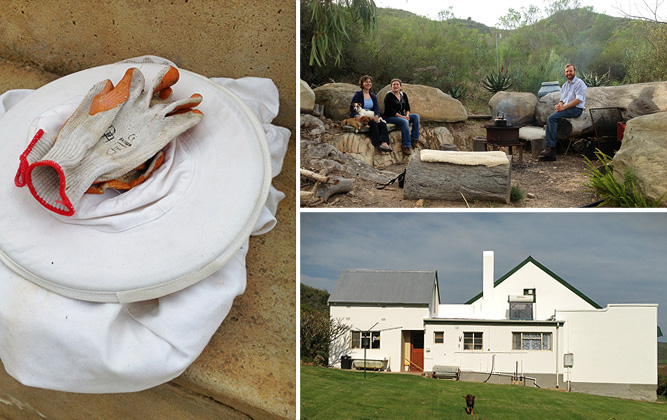
Our bee suits had been neatly laid out, complete with a thick pair of gloves. I must say that felt quite clumsy in my bee suit and a bit like I was a US Marine about to go into a toxic fume zone! Also, having a fairly large derriere, I kept on pulling my suit down over my thighs. I was promptly told not to do that by Patrizia, “otherwise you will get stung”, followed by a “besides, your bum is not that big anyway”. I was starting to really like these people!
Albertus showed us how to operate the bee smoker and we learnt that this is not to calm the bees down (as we thought), but rather to make them think that there is a fire, causing them to eat their honey in case they have to abandon the hive. When bees eat honey their abdomen extends, making them sluggish and less able to sting. The smoke also masks their alarm pheromones. Then we were shown what a beehive box looks like on the inside, with an explanation of all the parts. Turns out that bees are “like little German engineers” and if you don’t set up a beehive box according to their precise standards they won’t live in it. Basic lesson complete, we were now set to go to a real hive and rob them of their honey (which, by the way, contains bee spit).
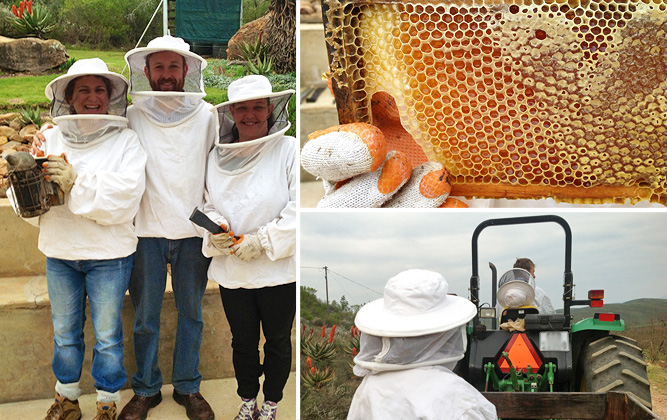
A short tractor ride later, we arrived at the chosen hive and Albertus gave the entrance a good smoking. Then he handed over the smoking machine to my friend (I was taking photographs), took off the roof of the hive and my friend was instructed to start smoking the hundreds of bees that were crawling along the top of the hive. They took off in all directions and while I was quite proud of myself for remaining calm in the midst of a bee storm (slight exaggeration, it wasn’t THAT bad) I suddenly felt a sharp pinprick on my calf. I had been stung. Feeling slight disbelief at my bad luck, I said “Hello! I have stung.” But neither Albertus or my friend paid me any attention as they were busy smoking out the hive. I wondered just how soon the entire bee gang would come in for the attack. (When you get stung the sting releases pheromones and this causes any other bees in the area to sting you too.) I raised my voice (slightly) and said (as calmly as I could) “Guys, I’ve been stung. Where should I go?” looking around (slightly frantically) for a place to run to. “Oh dear” said Albertus who came over to inspect my legging-clad calf. “That’s a shame. Are you sure?” I was pretty sure that it was a sting and to make sure that none of the other bees caught wind of this my calf was smoked. In fact my entire body was smoked for good measure. It worked though, no bees came near me after that!
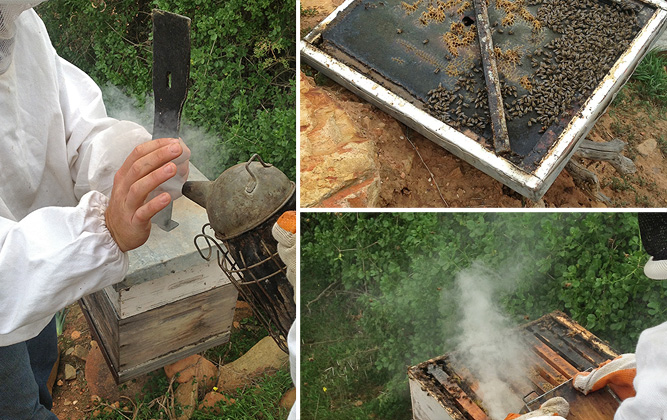
Albertus got the honey we came for and then we closed up the hive, said our thank you’s and headed back to the farmhouse. It really wasn’t that bad or scary (even the sting didn’t burn too much), but what amazed me the most was that Albertus didn’t wear gloves. He handled the beehive and frames completely bare-handed! I wouldn’t suggest you try this at home as he has loads of experience and obviously feels comfortable around bees. Perhaps he has bee-whisperer abilities too.
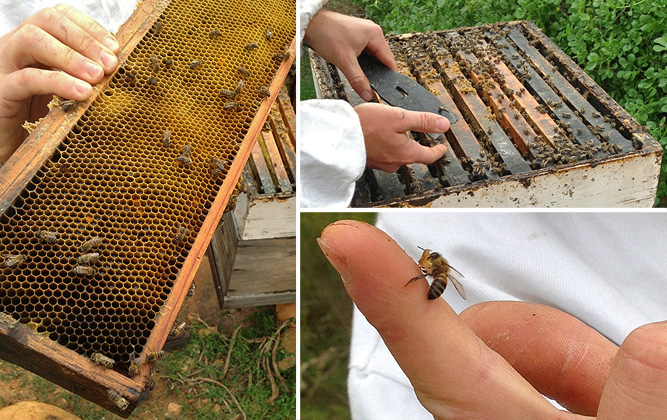
While we were out foraging for honey, Patrizia had set the table for a tasting of their farm produce. We happily chatted about figs, wine and the sex lives of bees around the table while enjoying more fresh bread with various delicious preserves, figs and nuts grown on the farm, along with generous lashings of honey of course! Albertus was particularly proud of his home-made mampoer and grappa, which we were allowed small sips of. Some of it was literally breathtaking and I was glad that we had eaten plenty of bread that day to line our stomachs!
By the end of the morning I was so enthusiastic about bees that if the Redbeard’s had any beehive boxes for sale (they will have some in stock soon), I probably would’ve walked out with one to set up in my own garden. Apparently beehives do well in city gardens, no matter the size. According to Albertus, the bees won’t sting you if you stay out of their flight path to the entrance of the hive. As I gently rubbed my stung calf as we drove off I wondered what my neighbours would think of me having a hive in my courtyard. I am sure they would appreciate the honey and the pollinated flowers? In the meantime, I know I have a greater appreciation of beekeepers, bees and the amazing work they do.
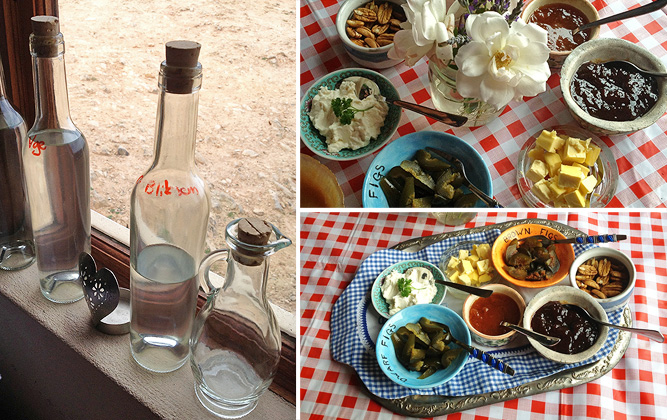
Bee facts
- It takes 12 bees their entire lifetime to make a teaspoon of honey.
- Bees visit up to 100 flowers during each nectar-hunting trip.
- Bees collect nectar from flowers and through chemicals in their saliva turn the nectar into sugars. This mixture is stored in the beeswax comb and fanned by the bees wings until most of the water has evarporated.
- Bees pollinate flowers while they are collecting nectar. Pollen sticks to the bees and rubs off on the next flower they visit.
- All the worker bees are female (smug smile from all the ladies), while the male bees, called drones, have only one job and that is to mate with the queen (smug smile from all the men).
- A queen bee lays up to 2 000 eggs a day and can lay up to a million eggs in her lifetime.
Fun bee-related trivia
It is said the term honeymoon originated in Babylon 4 000 years ago when newlyweds were given mead for a month after their wedding. Mead is essentially honey beer and since Babylon used a lunar calendar the month was referred to as “honey month”, which we have adapted to be honeymoon.
Why bees need to be protected
Honey, whilst delicious and good for you, is merely a sideline operation. Bees are essential in the production of food as they are pollinators. Without pollinators (birds, butterflies and beetles are pollinators too) plants wouldn’t be fertilized and then wouldn’t be able to produce food. This process is so important that farmers are known to hire beehive boxes so that the bees can go about pollinating their crops. Unfortunately, bee populations around the world are declining at a rapid rate due to many factors, most of which are the fault of humankind. This needs to be addressed before we have a crisis on our hands.
For more information on bees and how you can help protect them, go to www.buzzaboutbees.net
Farm experiences with Farmer Redbeard
You can join in various hands-on farming experiences with Farmer Redbeard as well as beekeeping. Some of the activities are:
- pruning or harvesting fruit from the vines and orchards
- crushing grapes with your feet in a vat
- making wine, mampoer or grappa the traditional way
- learning the secrets of fruit preserve or jam making
- herding sheep
These activities generally include a farm-style lunch.
You can also stay on the farm in one of their cottages or in the farmhouse dating back to the 17th century.
Contact Farmer Redbeard
Tel 023-615-1204, email [email protected], www.farmerredbeard.co.za


















